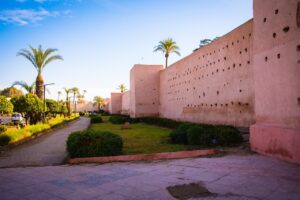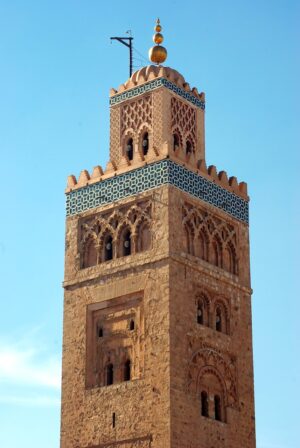Marrakech stands as one of Morocco’s most captivating cities, rich in history, cultural fusion, and architectural marvels. Since its founding in the 11th century by the Almoravid dynasty, the city has been a central hub of Moroccan life, blending Arab, Berber, and later, European influences. The Medina, or old town, has always been the beating heart of Marrakech, a labyrinth of narrow alleyways, bustling markets, and historic sites, preserved in their traditional layout and character. Here, the grand Djemaa el-Fna square continues to thrive as a vibrant social and cultural center, attracting storytellers, musicians, and artisans who maintain a centuries-old tradition of Moroccan arts and crafts.
Marrakech’s historical charm is deeply embedded in its architecture, with the city’s iconic landmarks standing as testaments to the artistry and religious devotion of its past. The Koutoubia Mosque, with its towering minaret visible from afar, is a symbol of both spiritual and architectural heritage. The Bahia Palace and Ben Youssef Madrasa, a former Islamic school, reveal the grandeur and intricacy of traditional Moroccan design with their lavish courtyards, zellige tilework, and finely carved wood.

In the early 20th century, Marrakech experienced a new phase of development under the French Protectorate, which introduced European-style neighborhoods and modern infrastructure. The French administration built Gueliz, the city’s first European district, a contrast to the Medina’s winding streets with its wide boulevards, tree-lined avenues, and arcaded buildings. This neighborhood attracted expatriates, merchants, and French officials, establishing an enduring colonial influence visible today in its architectural styles and French-inspired cafes.
Marrakech’s souks remain among the world’s most renowned, where generations of artisans practice traditional crafts, from pottery and leatherwork to textiles and jewelry. Moroccan artisans continue to create intricate goods that have attracted travelers for centuries, making the souks an integral part of the city’s identity and economy. The richness of Marrakech’s cultural landscape is further amplified by its deep-rooted spiritual traditions, with Sufi mystics, folk healers, and religious scholars contributing to the city’s mystical allure. Djemaa el-Fna, with its healers, fortune-tellers, and storytellers, has long been a place of both commerce and spiritual exchange.
The city’s gardens and palaces also offer glimpses into Marrakech’s past. The famous Majorelle Garden, created by French artist Jacques Majorelle, combines North African flora with vibrant cobalt-blue architecture, bridging Moroccan and French aesthetics. Meanwhile, the Agdal and Menara Gardens, which date back to earlier dynasties, reflect centuries-old Moroccan horticultural knowledge, merging beauty and utility.
Marrakech today is a living museum where every street, building, and marketplace reflects a chapter of its history. Visitors exploring the Medina, the colonial Gueliz district, and the grand historical landmarks of the city walk through a story woven with influences from both East and West. With its blend of tradition and modernity, Marrakech remains a city that preserves the soul of Morocco’s past, even as it adapts to the present.

